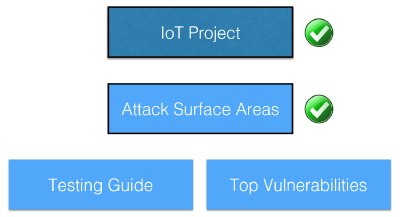This site is the archived OWASP Foundation Wiki and is no longer accepting Account Requests.
To view the new OWASP Foundation website, please visit https://owasp.org
OWASP Internet of Things Project
OWASP Internet of Things (IoT) ProjectOxford defines the Internet of Things as: “A proposed development of the Internet in which everyday objects have network connectivity, allowing them to send and receive data.” The OWASP Internet of Things Project is designed to help manufacturers, developers, and consumers better understand the security issues associated with the Internet of Things, and to enable users in any context to make better security decisions when building, deploying, or assessing IoT technologies. The project looks to define a structure for various IoT sub-projects such as Attack Surface Areas, Testing Guides and Top Vulnerabilities. LicensingThe OWASP Internet of Things Project is free to use. It is licensed under the http://creativecommons.org/licenses/by-sa/3.0/ Creative Commons Attribution-ShareAlike 3.0 license], so you can copy, distribute and transmit the work, and you can adapt it, and use it commercially, but all provided that you attribute the work and if you alter, transform, or build upon this work, you may distribute the resulting work only under the same or similar license to this one.
|
What is the OWASP Internet of Things Project?The OWASP Internet of Things Project provides:
Project Leaders
Major ContributorsRelated Projects |
Email ListQuick DownloadIoT Attack Surface Mapping DEFCON 23 News and Events
Classifications
| |||||||
IoT Attack Surface Areas ProjectThe OWASP IoT Attack Surface Areas (DRAFT) are as follows:
|
What is the IoT Attack Surface Areas Project?The IoT Attack Surface Areas Project provides:
Project Leaders
Related ProjectsEmail ListQuick Download
News and Events
|
Top 10 IoT Vulnerabilities (2014) ProjectThe OWASP Top 10 IoT Vulnerabilties are as follows:
|
What is the Top 10 IoT Vulnerabiltiies Project?The Top 10 IoT Vulnerabilities Project provides:
Project Leaders
Related ProjectsEmail ListQuick Download
News and Events
|
ICS/SCADA ProjectThe OWASP ICS/SCADA Top 10 software weaknesses are as follows:
|
What is the ICS/SCADA Project?The ICS/SCADA Project provides:
Project Leaders
Related ProjectsEmail ListQuick Download
News and Events
|
A global grassroots organization that is focused on issues where computer security intersects public safety and human life.
Their areas of focus include:
- Medical devices
- Automobiles
- Home Electronics
- Public Infrastructure
A project focused on helping small business connect with security researchers to aid in securing their IoT-based products before going market.
Their goals include:
- Focus effort towards small business
- Build partnerships
- Coordinate efforts
- Curate informational resources
- Present research
Formed as an informal industry working group in 2005, today OTA is an Internal Revenue Service (IRS) approved 501c3 charitable organization with the mission to enhance online trust and empower users, while promoting innovation and the vitality of the internet. OTA is global organization supported by over 100 organizations headquartered in Bellevue, Washington with offices in Washington DC.
Addressing the mounting concerns, in January 2015 the Online Trust Alliance, established the IoT Trustworthy Working Group (ITWG), a multi-stakeholder initiative. The group recognizes “security and privacy by design” must be a priority from the onset of product development and be addressed holistically. The framework focuses on privacy, security sustainability. The sustainability pillar is critical as it looks at the life-cycle issues related to long- term supportability and transfers of ownership of devices and the data collected.
The AllSeen Alliance is a Linux Foundation collaborative project. They're a cross-industry consortium dedicated to enabling the interoperability of billions of devices, services and apps that comprise the Internet of Things. The Alliance supports the AllJoyn Framework, an open source software framework that makes it easy for devices and apps to discover and communicate with each other. Developers can write applications for interoperability regardless of transport layer, manufacturer, and without the need for Internet access. The software has been and will continue to be openly available for developers to download, and runs on popular platforms such as Linux and Linux-based Android, iOS, and Windows, including many other lightweight real-time operating systems.
The Industrial Internet Consortium (IIC)
The Industrial Internet Consortium is the open membership, international not-for-profit consortium that is setting the architectural framework and direction for the Industrial Internet. Founded by AT&T, Cisco, GE, IBM and Intel in March 2014, the consortium’s mission is to coordinate vast ecosystem initiatives to connect and integrate objects with people, processes and data using common architectures, interoperability and open standards.
Securing Smart Cities is a not-for-profit global initiative that aims to solve the existing and future cybersecurity problems of smart cities through collaboration between companies, governments, media outlets, other not-for-profit initiatives and individuals across the world.
Talks
RSA Conference San Francisco
Securing the Internet of Things: Mapping IoT Attack Surface Areas with the OWASP IoT Top 10 Project
Daniel Miessler, Practice Principal
April 21, 2015
---
Defcon 23
IoT Attack Surface Mapping
Daniel Miessler
August 6-9, 2015
Podcasts
IoT Conferences
Conference Call for Papers




